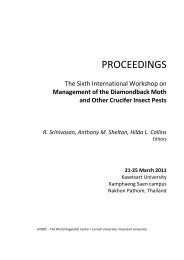Leguminous Vegetable Cultivation and Seed Production S ...
Leguminous Vegetable Cultivation and Seed Production S ...
Leguminous Vegetable Cultivation and Seed Production S ...
Create successful ePaper yourself
Turn your PDF publications into a flip-book with our unique Google optimized e-Paper software.
• Choose good quality, premium grade mungbean seeds of medium size with smooth seed coats.<br />
Remove broken <strong>and</strong> shriveled seeds. Be sure that beans are not treated with fungicides<br />
or insecticides.<br />
• Store seeds under cool <strong>and</strong> dry conditions to ensure high seed germination <strong>and</strong> sprout vigor.<br />
Beans stored under WC <strong>and</strong> 85% relative humidity produce good quality sprouts. <strong>Seed</strong>s with<br />
15% moisture can be safely stored for one year at 10 0 C or below.<br />
• Before soaking, wash the seeds in fresh water, stirring vigorously three to four times to allow<br />
the empty, broken <strong>and</strong> light seeds to float. Remove the floating seeds <strong>and</strong> debris. Repeat<br />
washing using fresh water every time until the beans are thoroughly cleaned.<br />
. In Taiwan, traditional earthen wares <strong>and</strong> stone jars are used for sprouting mungbean seeds.<br />
These containers have holes near the bottom to drain out excess water.<br />
• For larger quantity of seeds, use germination tanks of convenient size, preferably lined with tiles.<br />
Wash containers thoroughly with hot water (80 0 C) before use. Big plastic containers will also do<br />
• Arrange <strong>and</strong> perform all sprouting operations in a sheltered place to protect the sprouts from<br />
light. Darkness ensures bright white <strong>and</strong> long mungbean sprouts. Moderate temperature (23-<br />
28 0 C) <strong>and</strong> high humidity (85-90%) in the sprouting room help produce good quality crispy<br />
sprouts.<br />
. After washing, soak the beans in tap water at room temperature for eight hours. In the cool<br />
season, use warm water (32 0 C) for soaking. Put the soaked beans in containers. Do not fill the<br />
containers to more than 75% of their capacity to avoid overflowing when the seeds sprout.<br />
Apply a fine water spray or mist uniformly over the seeds at three-to four-hour intervals during<br />
the hot season Ad six to seven hours during the cool season. Apply just enough water to<br />
keep the sprouts continuously moist without drying.<br />
• A overhead water pipe line fitted with taps <strong>and</strong> movable water pipe or automatic sprinkler system<br />
connected to a timer are very convenient for watering.<br />
• Stage 1: Beans are swollen after eight hours of soaking.<br />
Stage 2: <strong>Seed</strong>s start germinating one day after soaking.<br />
Stage 3: <strong>Seed</strong>s germinate fully two to three days after soaking with 1 to 2 cm-long sprouts.<br />
Stage 4: Sprouts increase in length to 2 to 3-cm after three to four days soaking.<br />
Stage 5: Sprouts attain a length of about 5 cm or more in four to five days of soaking. In most<br />
countries, st<strong>and</strong>ard marketable sprouts are at least 5 cm long.<br />
Stage 6: Sprouts grow further, reaching a length of 8 to 9 cm after six to eight days of soaking.<br />
Longer sprouts are preferred by consumers in Taiwan.<br />
• Consumer preferences determine the size of sprouts produced. Relative sprout lengths at<br />
different stages provide a wide choice.<br />
Transfer sprouts of marketable size from the sprouting containers to drums/troughs or buckets<br />
for washing Wash <strong>and</strong> pack sprouts during early morning to avoid spoilage by high temperature<br />
after sunrise. Remove all broken roots, sprout pieces <strong>and</strong> other debris while washing.<br />
• Wash with fresh cold water three to four times to separate the seed coats still attached to the<br />
sprouts. Remove the sprouts from the drum using a basket or sieve.
















